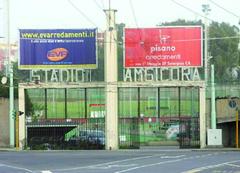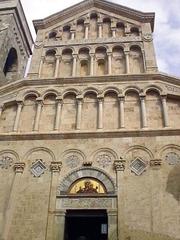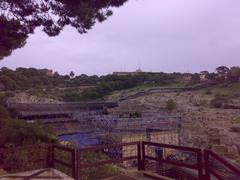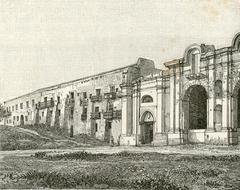
Archivio di Stato di Cagliari: Visiting Hours, Tickets, and Historical Significance
Date: 04/07/2025
Introduction
Nestled in the historic Castello district at the heart of Cagliari, the Archivio di Stato di Cagliari stands as a vital guardian of Sardinia’s documentary heritage. Established in 1332 by Alfonso IV of Aragon, the archive preserves over seven centuries of records, reflecting Sardinia’s dynamic political and social transformations under Aragonese, Spanish, Austrian, Savoyard, and Italian rule (archivissima.it; cagliariturismo.comune.cagliari.it). Its collections—ranging from medieval notarial acts and royal decrees to modern civil registries—make it an essential destination for historians, genealogists, and culturally curious travelers.
More than a repository, the Archivio di Stato di Cagliari actively engages the public through guided tours, educational workshops, and digitization initiatives. Its accessible location in the Castello district allows visitors to combine archival exploration with nearby landmarks such as Cagliari Cathedral and the Roman Amphitheatre (museionline.info). This guide details the archive’s historical context, key collections, practical visitor information, and travel tips to help you make the most of your visit.
Table of Contents
- History and Evolution
- Collections and Research Value
- Visiting the Archivio di Stato di Cagliari
- Practical Tips for Visitors
- Nearby Attractions and Suggested Itineraries
- Frequently Asked Questions (FAQ)
- Conclusion and Further Resources
History and Evolution
Origins and Foundation
The Archivio di Stato di Cagliari was formally established in 1332 in the aftermath of the Aragonese conquest of Sardinia. Created to centralize the documentation of the new Regnum Sardiniae (Kingdom of Sardinia), it quickly became a repository for governmental, legal, and fiscal records. Over the centuries, each wave of foreign dominion—including the Spanish, Austrians, and Savoyards—added layers to its collections, making the archive a unique witness to Sardinia’s complex history (archivissima.it; cagliariturismo.comune.cagliari.it).
Transformations Through Political Change
During the Aragonese (1323–1417) and Spanish (1418–1720) periods, the archive expanded its holdings with royal decrees, judicial proceedings, and correspondence with central authorities. The brief Austrian interlude (1708–1717) introduced new administrative practices, which were later further transformed under the House of Savoy from 1720 onward, leading to the merging of Spanish and Savoyard records (maas.ccr.it, pp. 740–750).
The 19th-century “perfect fusion” with the Kingdom of Piedmont (1847–48) and subsequent Italian unification marked the archive’s transition from a general kingdom archive to a provincial institution. The influx of documents from suppressed religious and state offices during this period significantly enriched its collections (archivissima.it).
Collections and Research Value
Overview of Holdings
The archive safeguards over 12 kilometers of documentation, including:
- Magistrature of the Regnum Sardiniae: Records from 1323 onwards covering administrative, legal, and fiscal matters.
- Civil Registry and Military Records: Birth, marriage, and death registers (1866–1929); military conscription lists; draft cards; and judicial records (antenati.cultura.gov.it).
- Notarial and Ecclesiastical Documents: Deeds and contracts from centuries of Sardinian history.
- Private and Special Collections: Donations from notable Sardinian intellectuals and organizations (govserv.org).
Notable Documents and Genealogical Resources
- Capitoli Brevi (Capbreus): Registers on land tenure and feudal relationships from the 14th–18th centuries (maas.ccr.it, p. 742).
- Civil Status Registers: Essential for genealogical research, including indexed birth, marriage, and death records (antenati.cultura.gov.it).
- Military Conscription and Service Records: Detailing enlistment, assignments, and demographic insights, particularly valuable for tracing family histories and migration patterns.
Digital Access
A significant portion of the archive’s holdings, especially civil registers and military lists, has been digitized and made available via the Portale Antenati, ensuring both preservation and global accessibility.
Visiting the Archivio di Stato di Cagliari
Location and Accessibility
Situated in the Castello district, the archive is within walking distance of Cagliari Cathedral, the Bastion of Saint Remy, and other major sites. Public transport serves the area well, and a public lift connects Viale Regina Elena to the upper Castello quarter (Italy This Way). Parking is limited due to narrow streets; visitors are encouraged to use public lots and lifts.
The archive is wheelchair accessible, with ramps and elevators. Visitors with specific needs should contact the archive in advance to ensure a smooth experience.
Opening Hours and Ticketing
Opening hours may vary slightly by season and event, but generally are:
- Monday to Friday: 8:30 AM – 3:30 PM
- Saturday: 8:30 AM – 1:00 PM
- Closed: Sundays and public holidays
Admission is free for all visitors. Registration with photo ID is required for document consultation. Advance booking is not mandatory for general visits but is recommended for researchers and guided tours (museionline.info; Wikipedia).
Guided Tours, Events, and Facilities
- Guided Tours: Offered by appointment and during “Open Archives” events, providing insights into archival work and history.
- Educational Programs: The archive periodically hosts workshops, especially through its Scuola di Archivistica, Paleografia e Diplomatica, active since 1877 (Wikipedia).
- Amenities: Restrooms and cloakrooms are available. The archive lacks an on-site café, but the Castello district offers many dining options.
Practical Tips for Visitors
Language and Etiquette
Most staff speak Italian; some English may be available during events. Researchers should expect documents in Italian, Latin, or Spanish, depending on date. Dress respectfully, maintain silence, and follow staff guidance to protect the integrity of documents.
Document Consultation
- Registration and photo ID are required.
- Only pencils are allowed for note-taking.
- Photography of documents is permitted with staff approval.
- Some materials may be stored off-site; advance requests are encouraged.
Nearby Attractions and Suggested Itineraries
The archive’s central location makes it ideal for pairing your visit with other historical and cultural sites:
- Cagliari Cathedral: A 13th-century landmark with stunning art and architecture (Italy This Way).
- Bastion of Saint Remy: Offers panoramic views of the city and sea.
- Roman Amphitheatre: A testament to Cagliari’s Roman heritage.
- Citadel of Museums: Includes the National Archaeological Museum (The Tourist Checklist).
- San Benedetto Market: For a taste of local life and Sardinian produce.
Frequently Asked Questions (FAQ)
Q: Does the Archivio di Stato di Cagliari charge an admission fee?
A: No, admission is free.
Q: What are the current opening hours?
A: Typically Monday to Friday, 8:30 AM to 3:30 PM; Saturday until 1:00 PM. Closed Sundays and public holidays.
Q: Is the archive accessible for visitors with reduced mobility?
A: Yes, with ramps, elevators, and a public lift serving the Castello district.
Q: Are guided tours available?
A: Yes, by appointment and during special events. Contact the archive for scheduling.
Q: Can I take photographs of documents?
A: Photography is generally allowed for research purposes, with staff permission.
Q: Do I need to book in advance?
A: Booking is not required for general visits but is recommended for researchers and group tours.
Visuals and Media
View the location on Google Maps
Conclusion
The Archivio di Stato di Cagliari offers unrivaled access to Sardinia’s past, safeguarding centuries of legal, civic, and private records. With free admission, knowledgeable staff, and a central location amid Cagliari’s historical treasures, the archive is an essential stop for researchers, students, and travelers alike. Plan your visit today, explore its collections, and complement your archival experience with a tour of Cagliari’s vibrant Castello district and its iconic landmarks.
For the latest updates on visiting hours, exhibitions, and digital resources, consult the official archive website and related platforms. Download the Audiala app for audio tours and cultural insights, and follow us on social media for news and event announcements.
Summary and Encouragement to Explore Further
The Archivio di Stato di Cagliari provides a unique window into Sardinia’s evolving identity, preserving documents that chronicle political, social, and economic transformations through the ages (archivissima.it; antenati.cultura.gov.it). With its strategic location, comprehensive collections, and ongoing digitization initiatives, it welcomes visitors of all backgrounds to explore Sardinia’s rich heritage. Combine your archival visit with tours of the Castello district, the Cagliari Cathedral, and the Roman Amphitheatre for a truly immersive cultural experience.
Sources
- This guide draws on official and authoritative resources. For further information, please consult:








